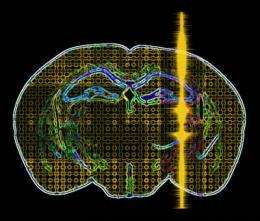'Sound' science offers platform for brain treatment and manipulation

The ability to diagnose and treat brain dysfunction without surgery, may rely on a new method of noninvasive brain stimulation using pulsed ultrasound developed by a team of scientists led by William "Jamie" Tyler, a neuroscientist at Arizona State University. The approach, published in the journal Neuron on June 9, shows that pulsed ultrasound not only stimulates action potentials in intact motor cortex in mice but it also "elicits motor responses comparable to those only previously achieved with implanted electrodes and related techniques," says Yusuf Tufail, the lead author from ASU's School of Life Sciences.
Other techniques such as transcranial magnetic and deep brain stimulation, electroconvulsive shock therapy and transcranial direct current stimulation are used to treat a range of brain dysfunctions, including epilepsy, Parkinson's disease, chronic pain, coma, dystonia, psychoses and depression. However, most of these approaches suffer from "critical weaknesses," Tyler says, including requirements for surgery, low spatial resolution or genetic manipulations. Optogenetics, for example, is one state-of-the-art technology that merges genes from plants and other organisms with the intact brains of animals to offer control of neural circuitry.
"Scientists have known for more than 80 years that ultrasound can influence nerve activity," observes Tufail. "Pioneers in this field transmitted ultrasound into neural tissues prior to stimulation with traditional electrodes that required invasive procedures. Those studies demonstrated that ultrasound pre-treatments could make nerves more or less excitable in response to electrical stimulation.
"In our study, however, we used ultrasound alone to directly stimulate action potentials and drive intact brain activity without doing any kind of surgery," Tufail says.
"It is fascinating to witness these effects firsthand," he adds. Tufail is one of four doctoral students in ASU's School of Life Sciences who worked with Tyler on the project. The team also included Alexei Matyushov, an physics undergraduate student in ASU's Barrett Honors College working with Tyler, and Nathan Baldwin, a doctoral student in bioengineering, and Stephen Helms Tillery, an assistant professor, with ASU's Ira A. Fulton Schools of Engineering.
"We knew from some of our previous work that ultrasound could directly stimulate action potentials in dishes containing slices of brain tissue," says Tyler. "Moving to transmit ultrasound through the skin and skull to stimulate the intact brain inside a living animal posed a much greater challenge."
Despite such challenges, the study shows how ultrasound can be used to stimulate brain circuits with millimeter spatial resolution.
"We've come a long way from the observations of Scribonius Largus, a Roman physician in the 1st century A.D. who placed electric torpedo fish on headache sufferers' foreheads to ease their pain," Tyler quips. "Our method paves the way for using sound waves to study and manipulate brain function, as well as to diagnose and treat its dysfunction."
In addition to advancing hope for noninvasive treatments of brain injury and disease, the groups' experiments in deeper subcortical brain circuits also revealed that ultrasound may be useful for modifying cognitive abilities.
"We were surprised to find that ultrasound activated brain waves in the hippocampus known as sharp-wave ripples," Tufail says. "These brain activity patterns are known to underlie certain behavioral states and the formation of memories."
The scientists also found that ultrasound stimulated the production of brain-derived neurotrophic factor (BDNF) in the hippocampus - one of the most potent regulators of brain plasticity.
Tyler says the fact that ultrasound can be used to stimulate action potentials, meaningful brain wave activity patterns, and BDNF leads him to believe that, in the future, ultrasound will be useful for enhancing cognitive performance; perhaps even in the treatment of cognitive disabilities such as mental retardation or Alzheimer's disease.
Tyler's students have also collected data that suggests that repeated exposure to low intensity ultrasound does not pose a health risk to rodents. "We examined many aspects of brain health following stimulation and found that low-intensity ultrasound is safe for repeatedly stimulating the brains of mice," noted Anna Yoshihiro, a neuroscience doctoral student in ASU's College of Liberal Arts and Sciences and co-author of the journal article. Yoshihiro works to treat Parkinsonian monkeys and has achieved some early success in treating epileptic seizures in mice using ultrasonic neuromodulation.
Monica Li Tauchmann, Yoshihiro's contemporary and co-author on the article, recalls the first time the method worked: "I was helping with experiments. We were trying to stimulate the brain of a living mouse with ultrasound. Not a whole lot was happening at first. Then, Dr. Tyler changed some of the ultrasound waveform parameters and the mouse started moving. We spent the rest of that day repeating the stimulation and the mouse was perfectly fine. It recovered from anesthesia as if nothing had happened. I think we were all astonished."
Tyler believes that there are a host of potential applications for ultrasound in brain manipulation. Besides basic science and medical uses, ultrasound represents a core platform around which future brain-machine interfaces can also be designed for gaming, entertainment and communication purposes because of its noninvasive nature.
"Space travel, hand-held computers, the Internet, and global positioning - not even a lifetime ago these things were mere science fiction. Today, they are commonplace," Tyler says. "Maybe the next generation of social entertainment networks will involve downloading customized information or experiences from personalized computer clouds while encoding them into the brain using ultrasound. I see no reason to rule out that possibility."
"To be honest," he adds, "we simply don't know yet how far we can push the envelope. That is why many refer to the brain as the last frontier - we still have a lot to learn."














